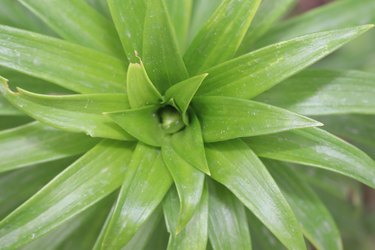
With its sword-like, red-tinged leaves, Dracaena marginata makes a striking addition to your indoor garden. Also known as Madagascar dragon tree and Spanish dagger, this evergreen tree is one of several Dracaena varieties typically grown as house plants. It can be kept outdoors in partial shade throughout U.S. Department of Agriculture plant hardiness zones 10 to 12, but take it inside before winter temperatures arrive. In addition to keeping your dracaena out of direct light and drafty areas, planting your Dracaena in the right soil will help your tree thrive.
Tip
Dracaena marginata prefers a slightly acidic, organically-rich and well-drained potting soil to thrive indoors.
Video of the Day
Dracaena Marginata Potting Soil
The best soil for Dracaena marginata is a mix that has a high nutrient content and is slightly acidic. Although the plant does best in humid conditions and likes moist soil, its soil must drain well. In poorly drained soil, the tree is at risk of root rot and other fungal diseases. The ideal soil for Dracaena marginata contains loam to add nutrients, peat to lower the pH level and vermiculite or perlite to improve drainage.
Video of the Day
Selecting a Potting Mix
Most garden supply centers have potting mixes for indoor plants. Although referred to as potting soil, most mixes do not contain soil because soil creates a heavy mix that doesn't drain well. Look for a potting medium that contains peat, vermiculite or perlite and some form of organic matter such as compost or bark.
If you want to make your own mix for your dracaena, combine one-third compost or fine bark chips, one-third peat and one-third vermiculite or perlite. Because it may not drain well and can contain insects and disease, never use garden soil for your potted plants.
Choosing a Container
The container for your Dracaena marginata must have at least one drainage hole in the bottom. Without this hole, the soil at the bottom of the pot can become waterlogged, leading to root rot. To allow the roots room to expand, choose a container wide enough to allow 1 to 2 inches of space between the roots and the wall of the pot. Don't use a container that is too large since this can lead to over-watering.
Because the Dracaena marginata is among the indoor plants that grow tall, up to 12 feet tall indoors and 20 feet tall in its natural habitat, it's best to choose a pot made of a heavy material such as terracotta or ceramic for stability. To make the tree easier to move, place the container on casters.
Increasing Humidity Levels
Dracaena marginata is native to the tropical island of Madagascar and thrives in humid conditions. To prevent mildew and mold, most homes are kept at low humidity. To boost the humidity around your dracaena and make it feel more at home, set the container onto a tray filled with pebbles. Fill the tray with enough water to keep the pebbles moist. The water level should only moisten the pebbles, not reach the base of your dracaena's pot.
Alternately, group smaller plants around the dracaena's pot. Add a cool steam vaporizer or humidifier near the plants to increase the moisture in the air. Mist occasionally and gently wipe the leaves with a damp cloth to remove dust and discourage pests.
Keeping Out of Reach
The members of the Dracaena species, including your Dracaena marginata should be kept out of reach of children and pets. Ingesting the leaves can cause gastric distress, including vomiting, hypersalivation and in cats, dilated pupils.
In addition to putting on gloves and safety glasses when trimming your tree, sterilize the cutting tools in rubbing alcohol or Lysol. Put all trimmed plant matter in the trash to prevent accidental exposure or ingestion by humans and pets.